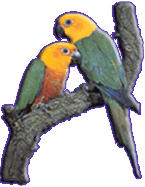|
|
| |
|
|
|
|
PALE-HEADED ROSELLA
Platycercus Adscitus |
|
|
| |
|
The natural habitat of pale-headed rosella is southeast part of Australia , that is from York Peninsula to northern New South Wales . There are two subspecies of Pale-headed rosella, Platycercus Adscitus Palliceps and Platycercus Adscitus Odseitus, which lives in the York Peninsula . Both subspecies are similar to the pale-headed rosella by the color of the feathers, but they are smaller. In the wild these rosella nests From February to June. They live on eucalyptus and fruit trees and on the blossoms of the genus “melaleuce” trees. |
|
|
Their favorite haunts are wide savannahs, were they forage for a variety of seeds and insects. However they are not unfamiliar with cultivated fruit plantations, sunflower and maize fields, which is a big problem for farmers. There are two mutations of pale-headed rosella, white and pastel. |
|
|
Adult rosella are about 30cm long. They have yellowish white head, white crop and blue breasts. Tail is in the under part bright red in its root, while out sided tail feathers are black blue and green. Feathers on the back are similar to scales and colored in blue and black. The nape is dark yellow orange, the legs are grey and the claws are black. The beak is pale grey almost white with darker end. Adults, mature pale-headed rosella are almost identical, however female has less pronounced pattern, smaller head, and in the under part of the wings show a bold pale band. The sexes are easier to distinguish when the birds are still young, because in their early age males are bigger and have wider beaks.
|
|
|
About fifteen years ago, European aviculturists marked the Pale-headed rosella as a rare bird. Since than, this species became highly popular among parrot lovers and commonly bred parrot in many aviaries.
Their diet should consist of various seeds like sunflower, canary seed, proso, oat, hemp, sorghum, corn and bright seed. Vitamins and minerals should also be included in every day diet. They enjoy eating apples, carrots spinach, cucumber, leaves of dandelion, parsley sprigs with leaves etc.
|
|
|
When the mating period begins, the male starts feeding the female, and the female starts visiting the nest. Mating occurs in early morning hours or late in the evening. After the mating, female lays 3 to 6 white eggs sized around 22mm. The incubation lasts for about 22 to 24 days. Females of the Pale-headed Rosella like to lay eggs in deep nest box, because those kind of nests are grit shelters from boring males and can provide peace they need. Rosella can sometimes rear two broods in a year. Youngsters mature very slow, so the best time for them to leave the nest is 32 to 35 days after hatching , and still they stay with their parents for one more next month. After that they start their own lives independently. Color of the feathers is different in youngsters. Youngsters have olive-russet head feathers. Breasts, back and tail have mix of dull colors. They assume their adult coloration after 12 to 15 months, that is after the second molt. In the same time they become sexually mature.
|
|
|
Having in mind the size of 33 cm, Pale-headed Rosella needs adequate, roomy cage if it is kept as a pet. The cage should be in a non-draughty place. Its optimum time for adapting to the new environment, new faces and voices, is one month. It should be fed once a day with fresh food and a mix of the seeds mentioned above, enriched with vitamins and minerals. In the molting period that lasts from April to September, the bird must get Vitacraft's food for molting and granules of iodine. All rosella species have quiet and nice song, they are not loud. Number of words that they can learn to imitate is limited. One more thing, once your rosella gets out of the cage, soon she will be on your shoulder, head or table. This bird is very friendly and curious and needs company. Don't make sudden moves, be gentle with her and you will have loyal and devoting feathery friend for a very long time. |
| |
|
|
| |
|
|
|
| |
| |
|
|
|

